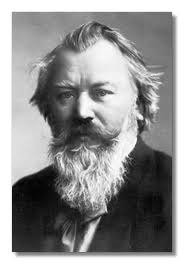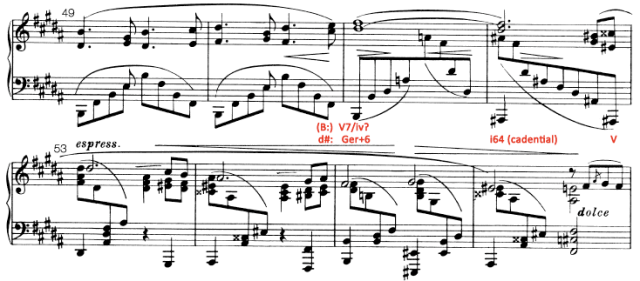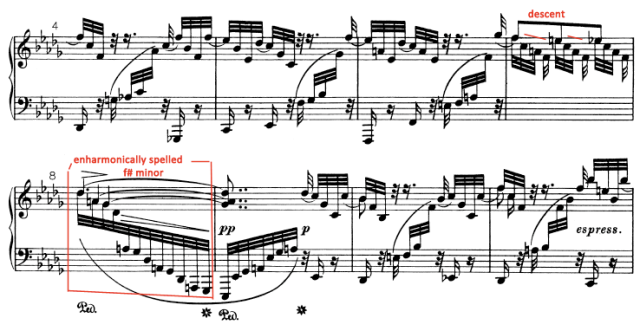 For the past few years, I’ve used Brahms’ ever-popular Intermezzo in A major Op.118 No.2 in my Theory III course as a kind of preparation for writing final analysis papers, and for good reason—it’s tightly-knit structure makes it ideal for motivic analysis, it provides great examples of chromatic harmony (plenty of secondary chords, mode mixture chords, and even “simultaneities”), but most importantly, it’s undeniably gorgeous and students, I find, become quickly attached to it.
For the past few years, I’ve used Brahms’ ever-popular Intermezzo in A major Op.118 No.2 in my Theory III course as a kind of preparation for writing final analysis papers, and for good reason—it’s tightly-knit structure makes it ideal for motivic analysis, it provides great examples of chromatic harmony (plenty of secondary chords, mode mixture chords, and even “simultaneities”), but most importantly, it’s undeniably gorgeous and students, I find, become quickly attached to it.
This year, when we came to the central hymn-like passage in F# major (mm.57-64) which serves as a kind of “eye of the storm” for the entire piece, we questioned why it is that Brahms enharmonically spells two chords right at the passage’s center:
 The two chords in red represent a iiø65–V progression tonicizing the a# minor chord that follows. But rather than using the proper spellings of b#ø65 and E# major, he switches to flats. Why did he not write it this way:
The two chords in red represent a iiø65–V progression tonicizing the a# minor chord that follows. But rather than using the proper spellings of b#ø65 and E# major, he switches to flats. Why did he not write it this way:
 The easy answer, the one I’ve always reverted to, is that he wanted to avoid those pesky double-sharps, making it easier for the pianist to read. But is this really a satisfactory answer? I think not. One might argue that reading the resulting augmented and diminished melodic intervals is just as awkward as reading double-sharps, not to mention the awkwardness of seeing so many flats in juxtaposition with so many sharps. Also, while it’s true that the key of A# minor (seven sharps) is perhaps a bit more cumbersome than Bb minor (five flats), this is only a briefest of tonicizations and not a full modulation. One might understand a composer switching to an easier spelling for an extended passage, but for two chords??
The easy answer, the one I’ve always reverted to, is that he wanted to avoid those pesky double-sharps, making it easier for the pianist to read. But is this really a satisfactory answer? I think not. One might argue that reading the resulting augmented and diminished melodic intervals is just as awkward as reading double-sharps, not to mention the awkwardness of seeing so many flats in juxtaposition with so many sharps. Also, while it’s true that the key of A# minor (seven sharps) is perhaps a bit more cumbersome than Bb minor (five flats), this is only a briefest of tonicizations and not a full modulation. One might understand a composer switching to an easier spelling for an extended passage, but for two chords??
I thought perhaps the F major chord might be referring to something else in the piece. From the home key of A major, F major is flat-VI, a good example of mode mixture, and mixture plays a big role is defining the Intermezzo’s overall character. An F major chord does appear in measures 20 to 21, but making a case that the m.60 F chord is referring to these measure seems a stretch.
Perhaps he’s placing visual emphasis on the piece’s precise midpoint. These two chords come at the center of this “eye of the storm” passage in a work whose overall form is a palindromic arch form. With 116 measures in the entire piece, these two chords sit almost precisely at the midpoint. Is this what he’s doing? A tepid “maybe.”
I wanted to see if there were instances of this kind of seemingly-arbitrary enharmonic respelling in other late Brahms piano works. The first passage that caught my eye is a very similar kind of passage in the very next piece in the Op.118 set–the Ballade in G minor. The central section of the piece finds its way to the chromatic mediant key of B major (via a wonderful non-resolution of a V7/iv in mm.38-40). The B major section sets out but soon modulates to d# minor (via a reinterpretation of a V7/IV chord as a German +6 chord), a key which requires the use of numerous double-sharps. Listen here.
 It’s true that switching from d# minor (6 sharps) to eb minor (6 flats) does not lessen the number of accidentals, at least it shows that Brahms had no phobia against double-sharps!
It’s true that switching from d# minor (6 sharps) to eb minor (6 flats) does not lessen the number of accidentals, at least it shows that Brahms had no phobia against double-sharps!
Then I remembered two passages from second Intermezzo from the Op.117 set.
First, measures 4 to 11. Listen here.
 The music, in B-flat minor, arrives in measure 8 at what sonically sounds like an F#/Gb minor chord, though it is enharmonically spelled untriadically (new word?) as Gb-A-Db. However, this enharmonic spelling is not arbitrary but rather is perfectly understandable, being driven purely by the voice-leading of the passage. The chord is not functioning as an f# minor chord but more as a simultaneity or an “apparent” chord. The obstinate A-natural, which stubbornly refuses to move to the expected Bb at m.8 (in order to create either a i chord or deceptive VI following the V chord at the end of m.7), retains its leading-tone function in anticipation of the Bb to come in measure 10. (The measure 9 chord is also a fun one to analyze! An enharmonically spelled ivø7?? A iv chord with the leading-tone substituted for the fifth of the chord (tonic), creating some kind of dual-functioning “plagal dominant”?? A “simultaneity” perhaps.)
The music, in B-flat minor, arrives in measure 8 at what sonically sounds like an F#/Gb minor chord, though it is enharmonically spelled untriadically (new word?) as Gb-A-Db. However, this enharmonic spelling is not arbitrary but rather is perfectly understandable, being driven purely by the voice-leading of the passage. The chord is not functioning as an f# minor chord but more as a simultaneity or an “apparent” chord. The obstinate A-natural, which stubbornly refuses to move to the expected Bb at m.8 (in order to create either a i chord or deceptive VI following the V chord at the end of m.7), retains its leading-tone function in anticipation of the Bb to come in measure 10. (The measure 9 chord is also a fun one to analyze! An enharmonically spelled ivø7?? A iv chord with the leading-tone substituted for the fifth of the chord (tonic), creating some kind of dual-functioning “plagal dominant”?? A “simultaneity” perhaps.)
So as interesting as this passage is, it sheds no light on the Op.118/2 passage containing enharmonic spellings, a passage driven not by voice-leading but by harmonic progression . Let’s move to the other fascinating passage in this Op.117/2 Intermezzo.
Measures 20 to 23. Listen here.
 In the somewhat tonally-ambiguous measures immediately preceding these, a low Db in the bass serves as a dominant orienting this brief passage in the key of Gb minor(!), which would have as its key signature (count ’em) 9 flats. Respelling these measures as F# minor (3 sharps) would result in 6 fewer accidentals! Yet, Brahms keeps the Gb minor spelling.
In the somewhat tonally-ambiguous measures immediately preceding these, a low Db in the bass serves as a dominant orienting this brief passage in the key of Gb minor(!), which would have as its key signature (count ’em) 9 flats. Respelling these measures as F# minor (3 sharps) would result in 6 fewer accidentals! Yet, Brahms keeps the Gb minor spelling.
If one suggests that the VI chord would have to be spelled as an E double-flat major chord (rather than as the less cumbersome D major) in order for it to function as the Neapolitan in the oncoming key of Db major (which it does), let’s remember that such a consideration of function did not prevent Brahms from spelling A# minor’s functioning dominant as F major in Op.118/2.
Therefore, it seems this passage provides us with an example counter to the one discussed in class. Explaining the Op.118/2 respellings as being done “for ease of reading” seems less convincing.
[Incidentally, the Op.117/2 passage just referenced reminded me of that wonderful extended passage from Schubert’s 4th Moments Musicaux written in F-flat major (8 flats). Schubert has taken the liberty in other pieces of respelling such keys, and in this case, respelling F-flat major as E major would have made perfect sense considering the latter’s close relationship with the piece’s home key of c# minor. But he leaves it as F-flat major.]
So back to Brahms 118/2. If the 117/2 passage puts a dent in my toss-away explanation for the respellings in 118/2, then why does he respell these two chords in the center of Op.118/2? I am sure that someone out there has written a dissertation on enharmonic spellings in Brahms and that someone has unlocked the mystery surrounding these particular measures. I’d love to hear other explanations. In the meantime, I’m inclined to believe that the best answer is the one provided by a students three seconds after I asked the question: “Why did Brahms spell these chords as Eb and F rather than D# and E#?”
“Because he felt like it!”


just a guess…but I doubt its an arbitrary thing. I don’t think he used Equal Temperament…so to him enharmonics were not the “same note”. They still aren’t. In this sense F makes more sense than E# by a long shot.
The other guess would be a copyist changed the spelling. Ives was famous for scolding them not to “correct” his accidentals. But these guys knew what they were doing.